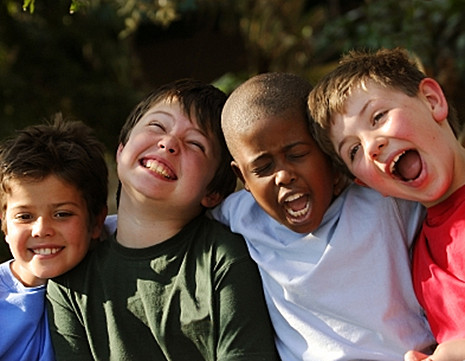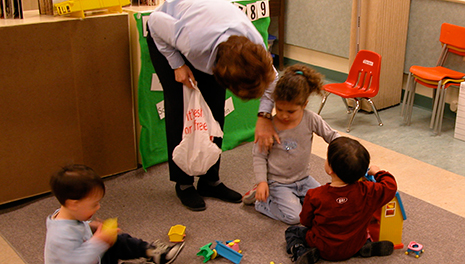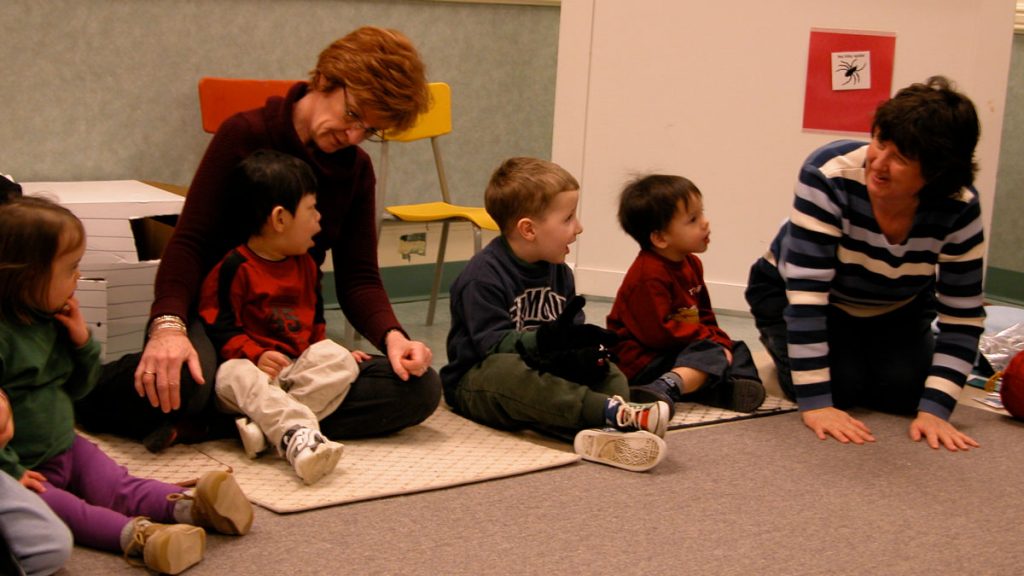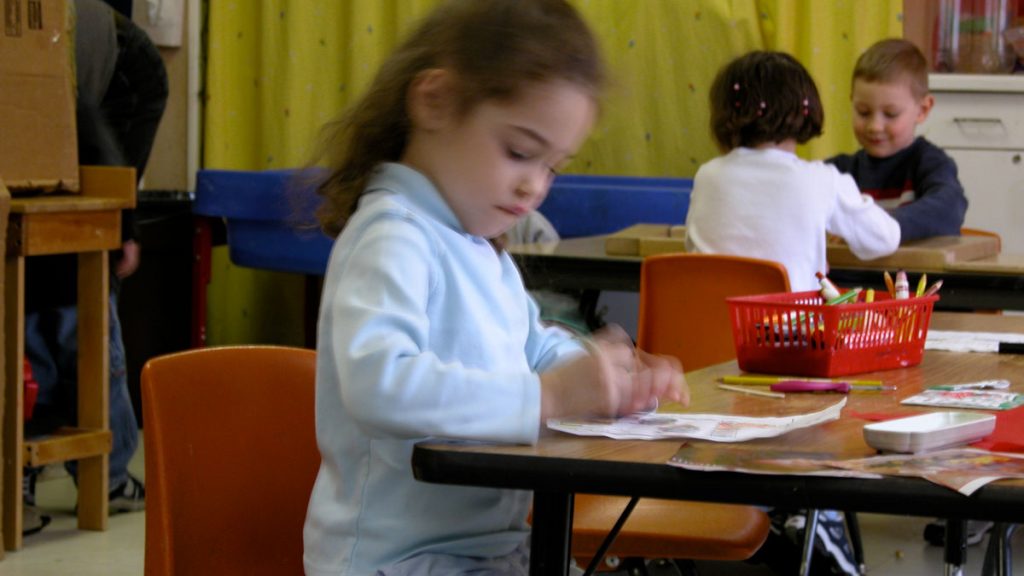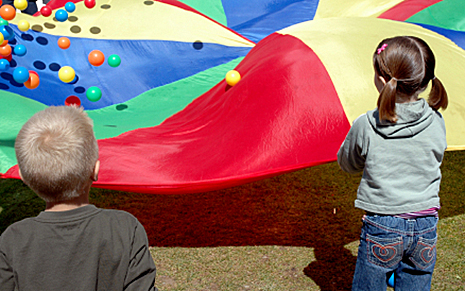
Introduction to Autism Spectrum Disorders
Introduction
Autism Spectrum Disorder (ASD) affects a child’s rate and pattern of development. This neurodevelopmental disorder* is common and may affect children to varying degrees. Children with Autism Spectrum Disorder have challenges with social interactions, communication and they often exhibit restricted, repetitive behaviours. Additionally, children with ASD may have learning and developmental challenges. Understanding the characteristics of ASD allows us to initiate modifications to help accommodate each child’s unique learning style. The information in this module will provide an understanding of ASD and suggest how to modify activities and the environment to meet children’s needs.
The Diagnosis
There are no medical tests for diagnosing Autism Spectrum Disorder. An accurate diagnosis must be based on observation of the individual’s communication, behaviour, and developmental levels. Because many of the behaviours associated with ASD are shared by other disorders, various medical tests may be ordered to rule out or identify other possible causes of the symptoms. To date, ASD is behaviourally diagnosed by trained clinicians following guidelines set forth by the American Psychiatric Association’s manual called Diagnostic and Statistical Manual (DSM).
According to DSM-V, released in 2013, an Autism Spectrum Disorder diagnosis involves deficits in the following two areas:
- Social interactions and communication
- Restricted, repetitive patterns of behaviour and interests
The range and degree of autism symptoms falls on a continuum, called the “autism spectrum”. Children with severe deficits as well as those who are mildly affected are therefore considered to have Autism Spectrum Disorder (ASD). Severity is based on social communication impairments and restricted repetitive patterns of behaviour (level 1-3).
By increasing knowledge about ASD and how it affects children’s development and learning, educators can help a child to reach his/her potential. ASD is a lifelong, neurologically-based developmental disorder.* It affects the child’s ability to communicate and interact with others, and how s/he perceives and responds to the world. Typically-developing children learn to do many things simply by watching and copying the actions of other people. Children with ASD are more likely to learn through direct teaching from an adult.
Some people with ASD show limited interest in social interactions, while others want to be around people but do not understand social “rules” and may have difficulty knowing how to behave appropriately. Repetitive behaviours such as becoming overly preoccupied with narrow or singular interests/topics, (e.g., collecting objects or facts) are common in individuals with ASD. Some people with ASD may have repetitive movements such as flicking their fingers, or flapping their hands. Young children with ASD may show limited play and/or use toys in atypical ways. A classic example is the child who lines up blocks in a row rather than building with them, or a child who spins the wheels on a toy car rather than making it drive.
Children who have ASD may have intelligence well above average or well below average, or anything in between. Many children have some level of intellectual challenge.
Differences in socializing, communication, thinking, or behaving associated with ASD also vary widely. Individuals with ASD have a normal lifespan. Estimates of the number of children with ASD indicate that it affects 1 in at least every 68 children.* It is approximately four times more common in boys than in girls. ASD is believed to be the third most common developmental disorder. (Center for Disease Control and Prevention, US Department of Health, 2018)
What Causes Autism?
The exact cause of ASD is still unknown. Scientists believe that both genetics and environment likely play a role in causing ASD. Imaging studies of people with ASD have found differences in the development of several regions of the brain. Studies suggest that ASD could be a result of disruptions in normal brain growth very early in development. These disruptions may be the result of defects in genes that control brain development and regulate how brain cells communicate with each other. Environmental factors may also play a role in gene function and development, but no specific environmental causes have as yet been identified. The theory that parental practices are responsible for ASD has long been disproved. Multiple studies have also shown that vaccination to prevent childhood infectious diseases does not increase the risk of autism in the population.
Assessing a Child
A developmental assessment involves getting to know the child and family in order to better understand his or her strengths and needs. Children’s development can vary greatly. Developmental disorders may only be diagnosed by physicians, psychologists, and/or psychological associates under the Registered Health Professions Act.
A developmental assessment may involve one professional, or several professionals from different disciplines. The child may be seen by a developmental pediatrician, psychologist, psychological associate, speech-language pathologist, occupational therapist, social worker, and/or other clinicians with expertise in child development. The assessment may involve more than one visit over a period of time.
At a developmental assessment, parents should expect to spend some time talking about how their child has grown and developed. Informal and/or formal observations of the child’s play and social interactions with others may also occur. When the assessment is completed, parents will have the opportunity to discuss the findings, impressions, and recommendations with the clinician(s). Typically, a report is written summarizing these results and recommendations, and it is then given to the parents and the referring physician.
Assessment Process
Information is obtained about the child’s skills within the major developmental domains:
- Social – interacting with other people
- Communication – conveying ideas through words, gestures, or other means and understanding others’ communication
- Verbal cognition – problem solving using verbal concepts
- Nonverbal cognition – problem solving without words (e.g., visual-motor, spatial skills)
- Fine motor – hand and finger skills
- Gross motor – larger body movements and balance
- Self-care (e.g., sleep patterns, eating habits, dressing skills, self-care)
- Early academic skills (e.g., sorting, organizing, shapes, letter and number recognition)
The child’s behaviour is observed to understand how the child responds to social cues, structure, use of prompts, imitation tasks, and sensory input. It is important to gauge the child’s attention span, as well as activity level and degree of impulsivity.
Parents and educators are asked to provide information about the child’s behaviour at home and in the child care setting. All members of the team provide information that can be used to determine whether the child meets the DSM-V criteria for Autism Spectrum Disorder. Sometimes, the decision to make a firm diagnosis is deferred until there is more information about a child’s behaviour in different settings.
Characteristics of ASD
The two main areas of development affected in children with ASD are social communication, and repetitive and inflexible behaviour and interests.
Area: Communication
For more information see Module 5: Developing Communication Skills.
- Difficulty with expressive language skills or speech. Some children may have very little speech, while others who talk (and may seem to have a history of normal language development) have difficulty with more advanced skills.
- Impaired comprehension or understanding of language (receptive language)
- Difficulty with both verbal (words) and nonverbal (gestures, body language) communication
- Difficulty with social use of language (e.g., greeting, informing, and requesting)
- Uneven language development. Many children with ASD develop some speech and language skills, but not at a typical level of ability, and their progress is usually uneven. For example, they may develop a strong vocabulary in a particular area of interest very quickly. Many children have good memories for information just heard or seen. Some may be able to read words before age five, but may not comprehend what they have read. They often do not respond to the speech of others and may not respond to their own names. As a result, these children are sometimes mistakenly thought to have a hearing problem.
Common characteristics include:
- Echolalia – repetition of words spoken by other people (echoing or parroting others)
- Pronoun reversals (e.g., difficulty with “you” and “I”; saying “You want a drink” instead of “I want a drink”)
- Unusual intonation patterns (e.g., loud, “robotic” or “singsong” voice)
- Abnormal use of pitch, rhythm, or stress
- Repetitive talking about their own narrow topics of interest
- Difficulty or differences in response to and use of facial expressions
- Difficulty using and understanding gestures
- Literal interpretation of language (e.g., “You could have knocked me over with a feather.”; “She cried her eyes out.”)
- Difficulty interpreting social language, such as sarcasm and jokes
- Difficulty using language to initiate interactions with others
Area: Social Skills
For more information see Module 7: Enhancing Social Skills.
- Difficulty interacting with others (both understanding other people and behaving appropriately in social situations)
- Restricted, limited, or unusual use of eye contact
- Appearing tuned out because of apparent lack of response to the presence of others
- Difficulty paying attention
- Turn-taking skills are challenging
- Difficulty with pretend play and imaginative games
- Lack of awareness of social cues – difficulty “reading” other people using cues like facial expressions
- Socially inappropriate behaviour (e.g., may lack awareness of personal space and come too close to others)
- Difficulty understanding others’ feelings
Area: Repetitive and Inflexible Behaviour
For further discussion see Module 2: Setting the Stage for Learning.
- There is great variability in the repetitive behaviours that children exhibit. Some children have more sensory or motor focus and others have a strong interest in special topics (that is, their behaviour and thinking, rather than their movements, are repetitive and inflexible).
- Behavioural characteristics do change over time (with some behaviours disappearing or being replaced by other behaviours).
- Children may be excessively active and have difficulty with attention (although attention skills may be good for activities of interest).
- An apparent lack of awareness or appreciation of danger (e.g., may wander out into the street in the middle of traffic, may climb onto the stove, may hang out of a window) is common.
- Specific fears that are so intense that they may interfere with the child’s ability to function during day to day activities (e.g., fear of bathing, fear of haircuts) can occur.
- Children may have sudden changes in mood which occur for no apparent reason.
Strategies to consider:
- Teach skills using a step-by-step approach
- Allow opportunities to practise skills until mastered
- Allow time and direct teaching in a variety of situations to generalize skills
- Recognize and build upon existing skills as some skills may be age appropriate or even above age level while others are delayed
How to Support a Child with ASD in the Classroom
Observation:
Learning environments that promote healthy child development are based upon the successful integration of techniques/ adaptations that are implemented by the educator through the process of regular observation. We know that each child is a unique learner and will absorb learning experiences and process information at his/her own pace. As educators we have developed many teaching strategies and adaptations to address individual learning styles with the goal of helping children to succeed. While one child may be comfortable with simple verbal instructions to complete a particular task, another child may benefit from a more intensive approach such as direct teaching, repetitive modeling, and task analysis. Educators who devote time for observation are motivated to provide learning experiences that children enjoy and find challenging. The classroom is not a stagnate environment. It is ever-changing and in order to maintain this level of growth it is essential to utilize daily observations of children and the environment.
Remember when thinking about how to accommodate or modify your classroom to start by focusing on the child’s strengths that you have observed. Ensuring that those strengths are able to flourish in your classroom.
In Module 3, you will learn additional systematic observation strategies.
Common Characteristics:
The following are common characteristics of ASD but they are not necessary for a diagnosis of Autism Spectrum Disorder:
- Sensory differences – over or under reactive to aspects of the environment
- Tactile defensiveness – distressed when touched by others yet may seek strong physical input, or may be easily distressed by the feeling of clothing tags or particular clothing material
- Auditory sensitivity – distressed by loud sounds, or specific sounds, or may be the first to hear sounds
- Strong interest in looking at lights, or sensitivity to sunlight when walking outdoors
- Repetitive activities that occur repeatedly (e.g., spinning objects, smelling objects, moving hands or objects near eyes, looking at objects out of the corner of one’s eyes – use of peripheral vision, head banging, self-biting)
- Insistence on following a particular route (e.g., always walking the same way to day care)
- Insistence on having objects or people in a particular location (e.g., each child has to sit at exactly the same spot at mealtime)
- Attachment to objects (e.g., always has to carry a piece of string or a toy car in one hand)
- Ability to repeat back, word for word, with the correct intonation, a song or even an entire videotape, exactly as it was first presented
- Special interest in and perhaps ability to talk about a topic of interest (e.g., details of bridge building, scores in hockey games)
- Interest in smelling objects/people, or distress when walking into a room with a smell barely detected by others
- Great distress or seeming indifference over temperature
- Apparent lack of reaction to pain
- Over-attention to aspects of the environment such as visual characteristics
- Eating difficulties – may have a restricted or limited range of food that is accepted; may have specific preferences that include refusal to eat anything other than a preferred brand name product
- Toilet training difficulties – may take a long time to learn to use the toilet and may have particular difficulty learning to use the toilet for bowel movements
- Sleep challenges – may have difficulty getting to sleep at night and may have frequent awakenings during the night (at times may be up for hours)
Strengths and Challenges:
Research has shown that, as a group, children with ASD often share a common set of strengths and face a common set of challenges. Every child has his/her own strengths and challenges, unique set of skills, or ability profile. Some of the characteristics are common among children on the spectrum, others are typical of ASD but not necessarily exhibited by all children.
Strengths:
- Visual learner
- Visual-spatial tasks are preferred
- Responds well to structure – consistency and repetition
- Learns new skills best in a quieter, controlled environment where there are fewer distractions (visual and auditory)
- Enjoys contact with familiar adults in social play, including different forms of physical contact
- Learns through the use of prompts – supports such as visual and verbal cues and physical guidance
- Learns new skills when taught in a supportive environment (i.e., supports, not just natural contingencies or rules)
- May have areas of relative strength in overall ability profile (e.g., puzzles, drawing, music, facts about topic of special interest)
- Shows pleasure in success with a challenge/activity
Challenges:
- Difficulty understanding and responding to oral instructions or language
- Attention – may miss important details and may attend to seemingly irrelevant details
- Imitation
- Difficulty using gestures and understanding facial expressions
- Initiating social interaction
- Following/understanding social rules/cues
- Regulating response to environment, emotional regulation – may have outbursts or exhibit distress
- Early play skills, independent play
- Imaginative play skills
- Transitions or shifting from one activity to another
- Generalization of skills from one situation to another
- Difficulty learning skills in “natural environment”
For more information see Module 2: Setting the Stage for Learning
| Characteristic | Modification |
|---|---|
| Difficulty with attention | Decrease distractions.Work at the child’s eye level. Teach one task at a time and break it into smaller steps if needed to help make it more attainable and less overwhelming for the child. |
| Difficulty with comprehension of language | Use short specific instructions – use key words. Supplement oral instructions with visual supports (consider routine/context, gestures, pictures, written words).Repeat pairings of words with picture/routine/object. |
| Difficulty with imitation and use of gestures | Exaggerate · Provide supports, prompts (see Module 3 for detailed information). Teach these skills explicitly. |
| Visual learner | Pair oral instructions with visuals (e.g., object, picture). Use visual supports and visual schedules. |
| Benefits from a structured, predictable routine | Provide routine. Reinforce appropriate behaviour and success with a meaningful reward. |
| Difficulty with transitions | Prepare the child in advance.Cue with visual as well as auditory information (e.g., use visual schedules, first/then approach, timer). |
| Difficulty identifying key details | Break tasks into smaller steps.Highlight key details with visual supports. Make salient information stand out. |
| Behavioural differences | Identify behaviour. Complete a functional assessment (see Modules 3 and 4). to generate possible functions or purpose of the behaviour (attention-seeking, access to tangibles, escape/avoidance, or sensory). Teach replacement skills – an alternative behaviour or a new way to communicate. |

